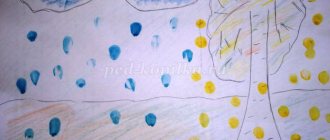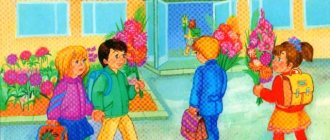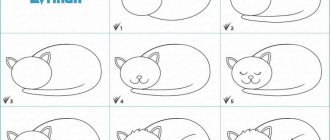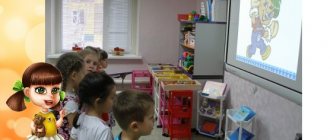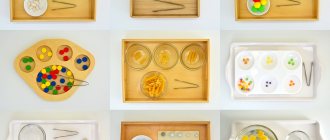Galina Klokova
Notes on drawing lessons using non-traditional image techniques.
Art activities using non-traditional
image technician in a preparatory school group.
Prepared by G. A. Klokova, teacher of the 1st category of kindergarten No. 25 “Ryabinushka” in Michurinsk, Tambov region.
Theme: “Autumn bouquet.”
Goal: development of creative abilities through the use of non-traditional drawing techniques : “leaf print”.
Objectives: - continue to introduce the genres of fine art (still life)
;
— learn to mix paints directly on the leaves;
— improve drawing skills using leaf printing and plasticine printing techniques;
— develop compositional skills.
Equipment: sheets of paper, watercolor paints, brushes, leaves and plant seeds, plasticine.
Notes on non-traditional drawing techniques in the senior group “Painting with salt”
Summary of an open lesson on visual arts using non-traditional drawing methods (painting with salt (sprinkling technique))
in the senior group on the topic: “Birch in winter attire”
Goal: to create conditions for the activation of speech and creative abilities during visual activities.
Tasks:
1. Educational: continue to teach children to draw a tree: trunk, branches. To shape children’s need for self-expression through visual activities. Introduce a new technique of unconventional drawing - the pouring technique. Strengthen the ability to mix paints.
2. Developmental: develop children's speech and creative abilities in the process of drawing. Develop fine motor skills, perseverance, attention, imagination and sense of composition. Develop the ability to comment on your actions.
3. Educational: to cultivate in children a sense of beauty, love for their native land through fine art and poetry. To cultivate an aesthetic attitude towards nature and its depiction in drawing. To develop independence in drawing and accuracy when working with paints.
Preliminary work: observing winter trees on a walk, looking at reproduction paintings and talking about them, reading and memorizing poems, listening to music, free drawing.
Materials and equipment: gouache paints, tinted paper, brushes for glue and painting, PVA glue, salt, napkins, audio recording of P. Tchaikovsky “The Seasons”.
Progress of the lesson
Educator:
I'll tell you a riddle,
And you solve it...
Many hands, but one leg... (Tree)
- That's right, it's a tree. What parts does a tree have? (Trunk, branches, leaves). A tree looks like a person. The trunk is the body, the roots are the legs, the branches are the arms, the shoots extend from the branches - the fingers, the bark is the skin of the trees. The older the tree, the more wrinkles there are. The snow lying on the branches is the clothing that people wear when cold weather sets in.
The teacher shows a reproduction of Grabar’s painting “February Blue” and a photo of “Snow-Capped Birches.”
Educator: The birch is called a symbol of Russia. The original name was given to her on behalf of Beregini, an ancient Slavic goddess who was the mother of all good intentions and spirits. Birch is an excellent air purifier. In spring, a birch tree can produce a bucket of sap in a day. Birch brooms can heal, cleanse, filling the human body with vitamin C and essential oils. In the old days, a birch torch was considered the best for lighting peasant huts - it burns brightly and without soot. But the main value of birch for us, Russians, is in its beauty, grandeur, and soulfulness. It is not without reason that poets, composers and artists at all times dedicated their works to her.
Lesson summary “Unconventional drawing methods”
— Did everyone succeed? (Check for correct execution in children).
- Well done.
- What else is our bird missing? (- Tail, eyes and beak)
- Certainly. Let's do the ponytail. And here a brush will help us.
- First, I draw the tail, and you watch.
“I dip the brush again in black paint and draw a small line down the middle, a little below the branch, and then add two feathers at the tail on each side.
— Is the task clear? (- Yes)
— Draw the bird’s tail yourself.
— Put black paint on the brush and draw a middle line and two on the sides. Vika does it with me. (See the guys' work)
- Well done. Wash the brush and place it on a napkin, let it rest for a while.
- Well, our bullfinch is almost ready.
- Now we need to make eyes for our birds. Look how I do it.
— I’ll take a cotton swab, dip it in white paint and put two white dots. Now I need to add the pupils. I'll turn the cotton swab over and put some black paint on the clean side. I'll put small dots in the middle of the eyes, these will be the pupils.
- Now you add eyes to your birds. (Check the result, help Vika)
— Have we drawn everything to the bullfinches? (- No)
- What is missing? (- Beak)
- Well done. You are very attentive.
— We will paint the beak with yellow paint, using a thin brush. I'll do it first. Look how.
-I take a small brush, pick up yellow paint and paint a small beak. (Show)
- Now you draw a beak for your birds. (Help Vika)
- Look how beautiful your bullfinches turned out.
— Bullfinches come to us with the first snow. Let's draw snowflakes too. To do this, take a clean cotton swab, dip it in a jar of blue gouache and apply small dots on our drawing, as if it were snowing. When making snowflakes, we again meet with the impression, only this time we make the impression with a cotton swab.
— We remove the cotton swabs.
VII. Lesson summary
- Look at your work. What beautiful birds you have made. Did you like them? (-Yes)
— At the beginning of the lesson, we talked about the fact that bullfinches really like to feast on rowan berries. Let's treat our bullfinches with rowan berries.
— Take a clean cotton swab, dip it in red paint and draw berries on a branch:
draw some berries - if you liked our lesson today and you are very pleased with your work
1 berry - if the lesson was boring and you think that you could do your job better.
I really liked today’s lesson, because you all tried hard, completing a new and difficult task. Therefore, I will also draw berries for my bird, and I will draw four of them, because I had four diligent students in my lesson today.
A set of classes using non-traditional drawing techniques
Educator: invites the children to be a little Santa Claus today and paint the window patterns themselves. The idea is discussed with everyone: severe frost means large relief patterns, light frost, forest, spruce branches, sprinkle with semolina and apply random dots and spots with paint.
Provide individual assistance by the teacher.
At the end, the children try to guess and tell from the drawings about the weather outside the window.
Theme: Spring tree.
Tasks:
to form an attitude towards plants as part of nature; teach children to draw using a “poke”; develop creative imagination; develop the ability to perceive colors in the surrounding world, reflect your impressions with the help of color images; cultivate a caring attitude towards nature.
Materials and equipment
: each child has a sheet of paper, pokes of different sizes, paints, water. Conduct a preliminary observation of the trees in the spring, paying attention to the shape of the first leaves. Reproductions: paintings by A. Savrasov “The Rooks have Arrived”. Literature: “Salute to Spring” by Z. Aleksandrovskaya, “Spring” by A. Pleshcheeva.
Progress of the lesson:
Read poems about spring trees (Willow, Birch, Alder). Looking at paintings and photographs of blooming and non-blooming spring trees.
Showing the sequence of work: children apply watercolor to a sheet of paper with a wide poke, turning the image into a plot drawing.
Provide individual assistance to the child by the teacher.
Topic: Dandelions.
Tasks:
teach children to imagine the image of a flower in accordance with its description in poems by poets; consolidate the skills of drawing with strokes with a semi-dry brush, with straight strokes when drawing a yellow flower head, and when depicting a white head, use the “spray” technique; develop the ability to reflect your impressions using color images; cultivate a caring attitude towards nature.
Materials and equipment
: each child has a sheet of green or blue paper, a toothbrush, a comb or a flat stick, a hard brush (bristles), watercolors, water. Conduct a preliminary observation of the trees in the spring - pay attention to the shape of the first leaves. Drawings, illustrations of dandelions. Story by A.M. Prishvin "Golden Meadow".
Progress of the lesson
Make a riddle, read poems about dandelions.
Looking at paintings and photographs of blooming and fading dandelions
Showing the sequence of work: children apply yellow watercolor with straight strokes on a sheet of paper with a semi-dry brush. When depicting white dandelion flowers, the leaf is covered with a stencil with a cut circle, white watercolor is used, a toothbrush is dipped with a stick and sprayed onto the leaf with sharp movements, after which the stencil is removed. The image is corrected and added to the plot drawing.
